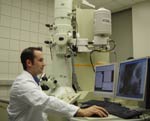


Methods are required that reliably detect nanoparticles and measure their physico-chemical properties in air, water, soil, and consumer products, the media in which humans and ecosystems are exposed to nanoparticles. To assess the risk of nanoparticles, additional tools are required that detect them in cells, fluids, or plant tissues.
Detecting nanoparticles is complex, both in gases and in liquids. Indeed, nanoparticles are so small that they cannot be detected by optical microscopes. In addition, chemical analysis of individual nanoparticles in gases and liquids was for a long time impossible due to their low mass. Only recently have methods become available for this purpose, so that even surface coatings may now be detected.
The prominent role of nanoparticles in areas of current interest such as climate and health research has favoured the development of technologies capable of detecting nanoparticles suspended in gas. Currently available instruments can detect particles as small as 3 nm, while new developments may reach the 1 nm limit. While the instruments used are not themselves size selective, they can be coupled with other instruments covering specific size ranges, for instance the low nanometre size range. Recently developed alternative procedures involving the use of a mass spectrometer allowed for very precise measuring of the chemical compositions of nanoparticles of specific sizes inside a gas.

In liquids, commercially available instruments can detect nanoparticles down to the 3 nm limit. However, most of the techniques to measure nanoparticles in liquids imply complicated sample preparation for analysis.
Electron microscopy is the usual method to study particle size, shape and structure in liquids and can currently detect particles below 10 nm. When equipped with a specific spectrometer, chemical composition can also be determined, at least for large nanoparticles. More...
Most people are routinely exposed to particles in ambient air, mainly from diesel fumes. Burning fuels produces a vast number of nanoparticles which are initially only about 10 nm in diameter but rapidly join together to form larger groups of up to 100 nm that may remain in the air for days or weeks. The air in a normal room can contain 10 000 to 20 000 nanoparticles/cm3 while concentration in urban streets can be 100 000 nanoparticles/cm3.
Exposure is low in terms of mass but significant in terms of numbers of particles. Every hour individuals breathe millions of nanoparticles, and it is estimated that at least half of these reach the lungs. However, it is not known what proportion of these are engineered nanoparticles.
Collecting samples of nanoparticles is a challenging task for several reasons. First, the collection must represent the real exposure at the site in question. Secondly, separation of nanoparticles from larger particles can only be achieved under certain conditions. Thirdly, it is necessary to collect huge volumes of air in order to obtain a mass that is large enough for some analyses. In addition, it is important to distinguish between existing ambient particles and engineered nanoparticles.
It is the number of particles, their size, and their surface characteristics that are determinant for interactions with living systems.
There is no clear opinion on which parameter(s) – mass, number of particles and/or surface area – should be measured as a most appropriate measure of assessing exposure. The available portable instrumentation for nanoparticle exposure is inadequate and new sampling techniques and strategies for assessing exposure at the workplace and in the environment should be elaborated. Also, the possibility of establishing Occupational Exposure Limits for chemicals in the form of nanoparticles should be considered. More...
Inhalation is the primary route of human exposure to nanoparticles. The different compartments of the human respiratory tract (nose, larynx, airways, lungs) all act as a filter for nanoparticles. The smaller the particle, the more likely its chance to reach the lung.
Motor vehicle emissions are the most significant source of nanoparticles in urban areas. Today, nanoparticles generated by the combustion of fossil fuels constitute the most important source of human-induced nanoparticles.
Engineered nanoparticles are likely to enter the environment either during the manufacture of nanomaterials or through the use and disposal of such products containing nanoparticles, including personal care products such as cosmetics and sunscreens. Currently, very little is known about the behaviour of these particles in the environment.
Exposure to nanoparticles at the workplace may occur in research and development facilities in the nanotechnology sector, in chemical and pharmaceutical companies, in facilities where paints, cement, and other products involving powder handling are manufactured, and during processes where nanoparticles are by-products such as in baking, welding and polymer processing. However, data on occupational exposure is scarce.
Potential dermal exposure concerns mostly cosmetic or pharmaceutical skin preparations that use nanoparticles. Although, in theory, these products could harm the area of skin where the product was applied or be adbsorbed through the skin, travel in the bloodstream and possibly harm other parts of the body, there is no scientific evidence of this as yet. But there is very little data on this route of exposure.
Ingested nanoparticles can move from the gut to other parts of the body through different mechanisms. Their ability to cross the lining of the intestine depends on their size and electrical charge. Once again, there is very little information on potential exposure through the digestive system. More...

This summary is free and ad-free, as is all of our content. You can help us remain free and independant as well as to develop new ways to communicate science by becoming a Patron!